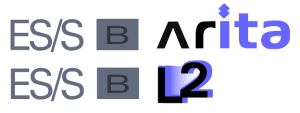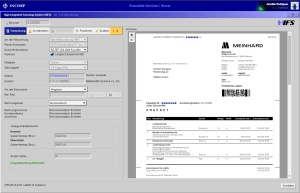Difference between revisions of "ES/S-B ARITA"
(→Legal) |
|||
| Line 153: | Line 153: | ||
== User Interfaces == | == User Interfaces == | ||
| − | ES/S- | + | ES/S-B ARITA is a server-side application, therefore, applications build around ARITA must (at least partially) implement their user interfaces themself. Historic applications often use terminal-based graphical user interfaces, more recent developments include full featured HTML5 Progressive web applications. |
| − | |||
| − | |||
| − | |||
| − | |||
| − | |||
| − | |||
| − | |||
| − | |||
| − | |||
| − | |||
| − | |||
| − | |||
| − | |||
| − | |||
| − | |||
| − | |||
| − | |||
| − | |||
| − | |||
| − | |||
| − | |||
| − | |||
| − | |||
| − | |||
| − | |||
| − | |||
| − | |||
| − | |||
| − | |||
| − | |||
| − | |||
| − | |||
| − | |||
| − | |||
| − | |||
| − | |||
| − | |||
| − | |||
| − | |||
| − | |||
| − | |||
| − | |||
| − | |||
| − | |||
| − | |||
| − | |||
| − | |||
| − | |||
| − | |||
| − | |||
| − | |||
| − | |||
| − | |||
| − | |||
| − | |||
| − | |||
| − | |||
== Signature == | == Signature == | ||
Revision as of 00:28, 12 July 2023
| ES/S-B ARITA ES/S-B L2 Platform | |
|---|---|
| Developer | Netroda Technologies |
| Product Family | Extensible Services / Server |
| Licenses | N.P.A.L., FoundationShield (EULA) |
| Initial release | 2015 (1998) |
| Current Version | 2.24 (July 2023) |
| Timeline |
Unnamed (2.24) (Current Version) |
| Platform | Windows NT, FreeBSD, GNU Linux |
| Compatible Databases | MySQL/MariaDB, Apache Cassandra |
| Type | Enterprise Resources and Business Applications |
| Programmed in | Multiple, Undisclosed |
| Origin |
|
| Language(s) | English, Deutsch, varies by used user interface |
ES/S-B ARITA (Named by the famous Cono de Arita Mountain in Argentina) is a powerful, modular high-reliability and high integrity Business Applications Server System developed on base of the Extensible Services / Server Business L2 Platform.
ARITA was the Second member of the ES/S-B Family, today, most new applications, modules and subsystems are created for L2, also known as the ARITA platform, because it has specific advantages. The most common use case includes enterprise resource planning, facturing, finance and warehousing.
In terms of complexity and specificality, ES/S-B engines are the most complex and sophisticated of the whole ES/S Product family, utilizing a enormous throughput of fiscally relevant data and containing specific routines for a large amount of use cases.
The ES/S-B L2 Core has been designed to maintain high stability and data integrity while offering good mantainability of data structures, seamless updating, migration and low process stacks to optimize processing speed at high concurrency.
Contents
Overview
The first version branded as ES/S-B was published late 2015. The predecessors are still used by enterprises wordlwide, that (altough with some efforts) can still migrate their business applications to the ES/S-B L2 Platform
Technical
The ES/S-B core system includes no default user interface but error messages. To be used, a functioning user interface must be supplied by the overlayed application. The result then can be called a ES/S-B Based (Web) Application. Without user interface however ES/S-B can still perform tasks, examples are integrated clearinghouse, automated facturing and API-only systems on finance and data processing.
To use ES/S-B as native application, the graphical parts are supplied within the hosting application, the vendor must then choose to implement logic and functionality on either sides, and implement control structures for the native applications by themselves using XML RPC or JSON.
Advantages againt the ES/S-B Standard runtime include
- improved stability and error detection
- advanced, more controlled module loading
- reusable UI-components (extensions)
- more flexible secondary factor options
- strict and dynamic structures (SR only supports dynamic)
- full NVFS integration
Additionally supplied modules
- hIFS High-integrated Facturing System
- PDF Generator
- DMI Finance Clearinghouse
- NVFS
- DatabusLT
- CashService
- EFTService
- Symbologies
- ENIA Imaging
- ENPS Printing System
- ESC/POS
- ESC/P
- ESC/P2
- IBM ProPrinter XL24
- DieboldNixdorf HPL
- PostScript
- PCL5/6
Legal
The exact level of legality in finance and business aplications depends heavily on the actual product, but in most cases designed for, ARITA/L2 conforms to the common standards and requirements of tax administrations and governments worldwide.
Example proven legal applicability
- PCI-DSS (Payment Card Industry Data Security Standard, Worldwide)
- GoBS 1995 (Federal Tax Gazette, Par. 7 Basic Law for the Fed. Rep. of Germany)
- GoBD 2014 (Federal Tax Gazette, Par. 7 Basic Law for the Fed. Rep. of Germany)
- KassenSichV 1977, 2022 (Tax code for the Fed. Rep. of Germany)
- SII AEAT 2017 (Agencia Tributaria de España)
User Interfaces
ES/S-B ARITA is a server-side application, therefore, applications build around ARITA must (at least partially) implement their user interfaces themself. Historic applications often use terminal-based graphical user interfaces, more recent developments include full featured HTML5 Progressive web applications.
Signature
System utilizing L2 or ARITA usually include the badge
"NETRODA TECHNOLOGIES A R I T A" or "NETRODA TECHNOLOGIES ARITA" and/or include the "ES/S" signature.
on receipts, user interfaces or else

